Abstract
Recent studies suggest that most 20–30 nm nanoparticles measured at roadsides are composed mainly of organic carbon derived from lubricating motor oil. Therefore, a simple particle generation system has been developed for controlled production of 20–30 nm nanoparticles of lubricating motor oil for inhalation toxicology studies by means of vapor condensation without addition of nuclei. Quasi-monodisperse particles with a modal diameter located at 20 nm and total number concentrations above 10 6 cm −3 were generated. Ten 2-h particle generation reproducibility tests were conducted, in which stability and repeatability of particle size and total number concentration were good. Organic carbon is a major component of oil particles, and organic analysis showed that the compositions of oil particles were not subjected to distillation of organic compounds through evaporation to condensation. Using the nose-exposure system connected to the particle generation system, toxicity of 20-nm particle organic compounds of lubricating motor oil can be assessed by inhalation studies of experimental animals.
1. INTRODUCTION
Road traffic is one of the major sources of particles in urban areas. Environmental quality standards have regulated particle mass; emissions of particles in the exhaust of diesel engines have been reduced over the past 20 years through the application of new technologies (CitationShi & Harrison 1999).
On the other hand, particle number size distributions with 20–30 nm modal diameter have been observed at roadsides (CitationShi et al. 1999; CitationMolnar et al. 2002; CitationCharron & Harrison 2003; CitationHasegawa et al. 2004; CitationKittelson et al. 2004; CitationNanzetta & Holmen 2004). Discussions are under way as to whether the variable of toxicological relevance is particle mass, surface, or number. It is necessary to evaluate toxicological properties of 20–30 nm nanoparticles in spite of their minor contribution to total mass because high concentrations were measured near roadsides, and the deposition ratio in the respiratory system is higher in the nano-size range than for particles in larger size ranges. The 20–30 nm nanoparticles observed at roadsides disappeared when the air was put through a thermal denuder, which indicates that nanoparticles are comprised of volatile materials (CitationHasegawa et al. 2004; CitationKittelson et al. 2004). The 11–30 nm nanoparticles are generated by condensation when the exhaust gases are diluted with ambient air during cooling (CitationCharron & Harrison 2003) and are generated by photoreactions with intense daytime solar radiation (CitationShi et al. 2001). Recently, size-resolved roadside atmospheric particles were collected with a cascade impactor, and then organic compounds were determined using gas chromatography/mass spectrometry (GC-MS), which indicating that organic compounds of < 50 nm nanoparticles were similar to those of lubricating motor oil of diesel car (CitationFushimi et al. 2005; CitationKubo et al. 2005).
On the other hand, according to the engine and chassis dynamometer studies, the 25–60 nm nanoparticles of diesel exhaust are made up mainly of organic compounds from unburned fuel and/or lubricating motor oil (CitationTobias et al. 2001). GC-MS analysis shows that the main components of nanoparticles emitted from diesel engines decelerating under conditions when fuel supply is cut and no combustion occurs inside the cylinder are organic compounds derived from lubricating motor oil (CitationKubo 2004). CitationKubo (2005) inferred that the mechanism by which nanoparticles of lubricant motor oil were generated under such deceleration conditions was as follows: components of lubricating motor oil deposited inside the cylinder evaporate and then condense in the absence of soot particles on which the vapors preferentially condense. In addition, nanoparticles are difficult to generate during combustion process at higher engine load. Thus, these results suggest that lubricating motor oil largely contributes to components of diesel nanoparticles and nanoparticles measured at roadside.
One way to study the adverse health effects of particle matter is via inhalation studies, which has been performed using ambient particle matter (CitationLi et al. 2003; CitationElder et al. 2004), diluted diesel exhaust particles (CitationReed et al. 2004), and laboratory-generated surrogates (CitationTakenaka et al. 2001). The advantage of using laboratory-generated particles for an inhalation study is that one can use a known chemical composition and control particle size and number; so, it becomes possible to study the health effects analytically. On the contrary, when an inhalation study is performed using ambient particle matter or diesel exhaust particles, it is difficult to concentrate particles of the desired size range; moreover, it is difficult to evaluate the influence of particles themselves because of interference from coexisting gaseous substances. Furthermore, when using ambient particle matter, it is difficult to supply air with stable particle concentrations and compositions because they vary with factors such as rain, wind direction, car numbers and types, day of the week, and time of the day.
Many kinds of particles have been generated for inhalation studies (CitationMuir & Cena 1987; CitationPillai et al. 1994; CitationEvans et al. 2003a, Citation2003b; CitationRoth et al. 2004); however, hydrocarbon particles below 100 nm have not been generated (CitationVeranth et al. 2003). CitationVeranth et al. (2003) generated nanoparticles (median 30–50 nm, particle number concentrations above 1 × 106 cm−3) for the first time employing hydrocarbons and used lubricating motor oil by condensing their components on NaCl nuclei. However, a study of the toxicological effects of the 20–30 nm nanoparticles of lubricating motor oil has not been conducted.
The objective of this study is to generate, as surrogates for the particles generated by diesel engines decelerating under conditions when fuel supply is cut and no combustion occurs inside the cylinder, 20–30 nm nanoparticles of lubricating motor oil in the size range observed at roadsides for use in inhalation toxicology studies. We generated nanoparticles by evaporation-condensation of fresh oil, which is expected to be the main process during such deceleration.
There are possibilities that components of lubricant motor oil are subjected to not only evaporation-condensation but also pyrolysis and transformation. However, it is expected that the lubricating motor oil included in emitted nanoparticles has not been exposed to the high temperatures of combustion gas under conditions of deceleration without combustion. Therefore, components of lubricant motor oil which are subjected to pyrolysis and transformation should be minor.
We designed a simple system to generate lubricating motor oil particles without addition of nuclei, because the oil contained additives, which are expected to serve as condensation nuclei. We checked the reproducibility of the generated particles and a volume-weighted size distribution correlated to mass-weighted size distributions. Further, we collected oil particles and analyzed their organic carbon and organic compounds. We also describe the performance of the particle generation system.
2. METHODS
2.1. Particle Generation System
Lubricating oil particles were generated with a NPG-100 (Sibata). The NPG-100 consists of an oil-feeding unit, a tank covered by a mantle heater, a furnace, and a cooler (). The oil-feeding unit and the tank were connected by a plastic tube (TYGON, Saint-Gobain), and the other parts were connected by a stainless steel pipe.
FIG. 1 Schematic diagram of particle generation system NPG-100 and nose-exposure chamber SIS-20MB. Q1–Q4 refer to flow rates, and T1–T3 refer to measured internal temperatures of mantle heater, furnace, and cooler, respectively. SUS: pipe made of stainless steel.
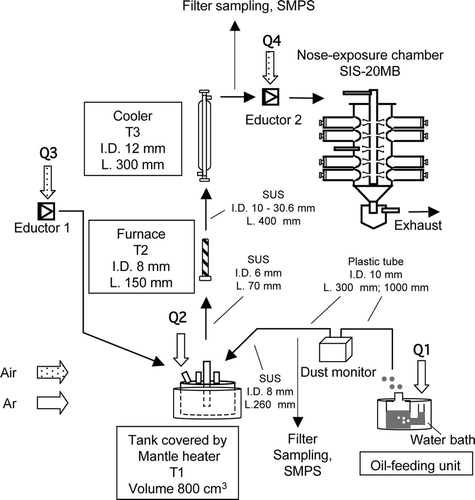
In the oil-feeding unit, an oil mist was generated by bubbling argon (purity 99.999%) through the oil and supplying it to the tank. A chamber in the oil-feeding unit was filled with oil and soaked in a hot water bath to lower the viscosity of the oil; the temperature of the water was set from 60 to 80°C according to the viscosity of the oil. An increase of the argon flow rate (Q1) causes an increase in the feed rate of the oil mist.
In this study we employed three kinds of fresh oil to generate oil nanoparticles. Two are commercially available ones by different manufacturers (Oil-A and Oil-B), and the other is polyalphaolefins (PAO), which is a synthetic base oil ().
TABLE 1 Measured properties of oil used in this study. N.M. = not measured
To prevent changes in the components of the original oil (i.e., to prevent distillation of oil components), the oil mist was introduced into the tank covered by the mantle heater (100 V, 450 W) and immediately vaporized. Since numbers of different boiling point of organic compounds included in oil, oil feeding by mist and immediate vaporization enable the similar compositions between vapor and original oil.
The furnace (100 V, 200 W, 8 mm internal diameter, 150 mm length) was located downstream of the tank, which was used to support the mantle heater. The temperature of the mantle heater and furnace can be set from an ambient temperature to 800 and 400°C, respectively. The internal temperatures of the tank (T1) and furnace (T2) depend on the preset temperatures, argon flow rates, and air flow rates. The air temperature inside the tank and the furnace was monitored with a thermocouple. The vaporized oil components were transported with the argon (Q2) to the cooler.
The vaporized oil was introduced into the cooler for condensation and particle growth by lowering the temperature. The cooler consisted of two concentric glass pipes with cooled water circulating through the outer pipe while the air went through the inner pipe. The water temperature can be set arbitrarily, it was set to 2°C in this study. Internal air temperature at the exit point of the cooler (T3) was monitored with a thermocouple.
HEPA-filtered compressed room air was added from upstream (Q3) and downstream (Q4) of the NPG-100 and then connected to the nose-exposure chamber (SIS-20MB, Sibata; ) to expose a mouse and rat to particles. To keep oxygen concentration over 20% at the nose-exposure chamber, oxygen was added via mixing with diluted air (Q4). The exhausts were thrown off to the outside through the HEPA filter using a blower.
2.2. Evaluation of Number Size Distribution of Oil Particle
The particle number size distribution was measured with a scanning mobility particle sizer (SMPS 3936, DMA 3085, CPC 3025A, TSI). The sample flow rate was operated at 0.3 L min−1 with 3.0 L min−1 sheath flow, which corresponds to a measuring size range of 4.53–159.63 nm and 677 nm for the inertial impactor with a 50% cutoff particle diameter. The flow rate was checked with a soap bubble flow meter (Gilibrator-2, Gilian). Additionally, intermittent monitoring of number concentrations of superior-sized particles was conducted with the SMPS 3034 (size range: 10–486.97 nm; 50% cutoff diameter: 800 nm) and with an optical particle counter (KM-09, RION), which measured the number concentrations larger than 0.3, 0.5, 1.0, 2.0, and 5.0 μ m in diameter. Sample air was drawn downstream of the cooler.
2.3. Particle Sampling, Particle Mass, and Analysis of Organic Carbon and Organic Compounds
The feed rate of the oil mist was monitored with a dust monitor (LD-3, Sibata). To convert dust monitor counts to weight mass, dust monitor measurement and oil mist sampling with a quartz fiber filter (2500QAT-UP, Pall) were conducted simultaneously. Number size distributions of oil mists were measured with the SMPS 3034. Sample air was drawn downstream of the oil-feeding unit.
For obtaining the generation rate of oil particles, oil particles were sampled with the quartz fiber filter downstream of the cooler. Oil particles also were collected with an electrostatic precipitator (SSPM-100, SHIMADZU) on aluminum foil to analyze organic carbon (OC) and organic compounds. Amounts of OC were determined by a thermal method using a carbon analyzer (DRI model 2001) under the IMPROVE protocol (CitationChow et al. 2001) except for a fraction of EC3. Because aluminum foil cannot withstand such high temperatures (800°C), we analyzed the OC fraction, EC1, and EC2. Organic analysis of particles on the aluminum foil was conducted by thermal desorption-gas chromatography/mass spectrometry (TD-GC/MS) in SCAN mode (CitationFushimi et al. 2005). Also, oil was deposited on the aluminum foil and then analyzed under the same conditions for samples of oil particles.
Particle mass was obtained by incrementing the mass of the collection media after sampling. Weights were measured by an electrical microbalance (M5P-F, SARTORIUS) in an air-conditioned chamber (CHAM-1000, HORIBA) at constant temperature and relative humidity conditions (25°C, 50%). Each medium weight was measured two or more times and subsequently averaged if the difference was within 6 μg; the mean value was adopted for the weight of the medium. The water content in each medium affects measurement of the particle weight, especially in quartz fiber filters. Therefore, quartz fiber filters were stored in the chamber for 24 h to attain constant water content in the filters, and then weighed. Aluminum foil does not require such a procedure because the mass of the water content may be negligible compared with increments of particle mass.
3. RESULTS AND DISCUSSION
3.1. Number Size Distributions of Oil Particles and Performance of Particle Generation System
In our operating variables used with the NPG-100 to generate oil particles (), Q1–Q4 and T1–T3 correspond to argon and air flow rates and measured internal temperatures (). Each flow rate and temperature was adjusted to generate the number size distribution with modal diameter 20 nm. We determined standard operating conditions that generate particles of 20 nm () as well as the corresponding size distribution () averaged over 2 h.
FIG. 2 Number size distribution of oil particles generated under the standard operating conditions listed in (measured with SMPS 3936 and 3034).

TABLE 2 Operating variables of NPG-100 and the standard operating conditions to generate 20 nm oil particles. Q1–Q4 and T1–T3 correspond to argon and air flow rates and measured internal temperatures shown in , respectively
Oil particles with a modal diameter of 20 nm (number geometric mean diameter 20 nm, geometric standard deviation 1.34) were generated under standard operating conditions (). No particle increments were found in other size ranges, so a quasi-monodisperse oil particle with a modal diameter of 20 nm could be generated without addition of nuclei.
The duration of the continuous examinations were limited to 2 hours to avoid causing stress to the animals in our inhalation study. The time variation of the modal diameter, number geometric mean diameter, and total number concentrations (measured with SMPS 3936; 4–160 nm) were determined over 2 h (). Particle size and total number concentrations were stable during particle generation in this period.
FIG. 3 Time series of modal diameter, number geometric mean diameter, and total number concentrations (measured with SMPS 3936; 4–160 nm). Oil particles were generated under the standard operating conditions listed in .
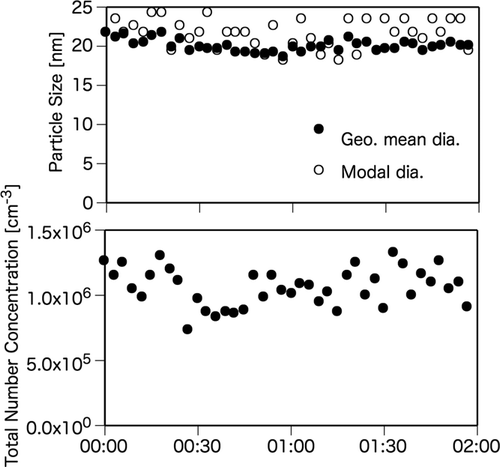
It is necessary to consider the reproducibility of generated particles for inhalation studies. The number geometric mean diameter, geometric standard deviation, and total number concentrations ranges were 20.0–26.8 nm, 1.32–1.34, and 1.0–2.9 × 106 cm−3, respectively (). The NPG-100 showed good performance in continuing and reproducing the generation of particles with stable size distribution and particle numbers; it is suitable for inhalation studies.
FIG. 4 Reproducibility test results of modal diameter, number geometric mean diameter, and total number concentrations (measured with SMPS 3936; 4–160 nm). Oil particles were generated under the standard operating conditions listed in . Plotted points indicate mean values of each 2-h period, and vertical bars indicate standard deviation.
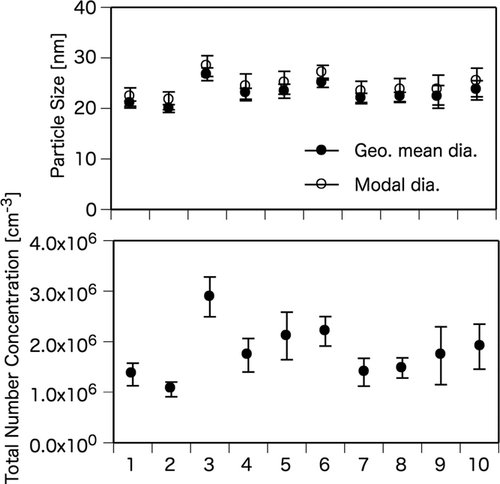
We measured particle number concentrations in a system background to check for the contributions of other particles; we also measured the particle number size distribution with the oil supply at ambient temperature to validate the vaporization and condensation of oil components.
Number size distributions were determined for the system background (BG; ambient temperature with no oil supply), oil supply with ambient temperature (Oil*), and oil particles generated under the standard operating conditions (Oil) measured with the SMPS model 3034 and optical particle counter (OPC) (). The flow rates of Q2, Q3, and Q4 were set at standard operating conditions in BG, and all flow rates were set at the standard operating conditions in Oil*.
FIG. 5 Number size distributions of particles in the system background (BG; ambient temperature with no oil supply), oil supply with ambient temperature (Oil*), and oil particles generated under the standard operating condition (Oil) measured with SMPS model 3034 and OPC. No particles larger than 300 nm were detected with the OPC in BG.
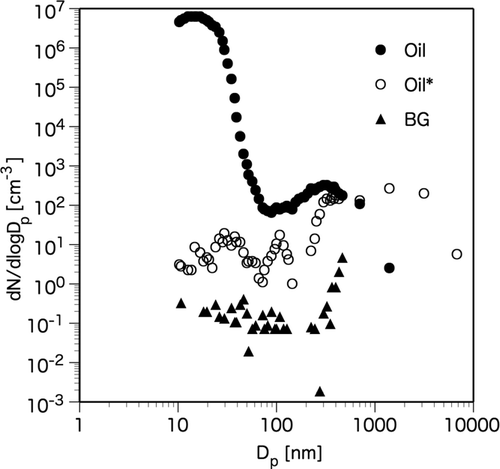
Few particles with diameters smaller than 100 nm and no particles larger than 300 nm were measured in BG. Background particles do not play an important role in the nucleation of oil particles. As oil was supplied to the tank without raising the temperature of the mantle heater and furnace (Oil*), particles smaller than 100 nm did not increase, which suggests that oil particles below 100 nm were generated from vaporization and condensation of oil mist, but not from the oil mist itself. Moreover, when the oil mist was measured with the SMPS, there were no particles smaller than 200 nm, and the number concentration was as low as 200 cm−3. So a high number of oil particles up to 106 cm−3 cannot be generated from the small number in the oil mist by means of shrinking. Therefore, we can conclude that 20 nm oil particles were generated from vaporization and condensation of the oil mist.
The number concentrations increased for particles larger than 100 nm whether the temperatures of the mantle heater and furnace were raised or not. The increment is thought to be due to a contribution of a part of the oil mist from the oil-feeding unit.
To evaluate the system performance, we conducted sensitivity tests on the oil feed rate and the temperature of the mantle heater and furnace ( and ). The oil feed rate at the standard operation conditions was 3.20 μg min−1, and the oil feed rate decreased from standard operating conditions in 2.56, 2.24, 1.60, and 0.32 μ g min−1, respectively, and the other parameters were kept at standard settings. When the oil feed rate decreased to 7/10 (2.24 μg min−1) of the standard value, the total number concentrations decreased to 1/500 of those generated under standard operating conditions. For further reduction of oil feed rates, lognormal size distributions were not measured, and most of the number of oil particles decreased. The supply of the oil mist is a critical factor for generating the oil particles.
TABLE 3 Parameters of size distributions of oil particles generated under the different oil feed rate (measured with SMPS 3936; 4–160 nm). The other parameters were fixed at standard operating conditions listed in
TABLE 4 Parameters of size distributions of oil particles generated under different temperatures of mantle heater and furnace (measured with SMPS 3936; 4–160 nm). Corresponding number size distributions are shown in and
The modal diameter and number concentrations increased with the mantle heater set to low temperature (). In the case of furnace temperature, the results were similar (). We also determined the result of the temperatures of the mantle heater and furnace lowered concurrently (). During this time, the modal diameter and number concentrations were relatively larger than those decreasing solely with either the furnace or mantle heater temperature. It was found that not only 20 nm particles but also larger particles as large as 60 nm could be generated by this particle generation system by adjusting the temperature of the mantle heater and furnace. Not shown in the figure, as the temperature of the mantle heater (< 100°C) and furnace (< 60°C) was lowered, modal diameter and number concentrations decreased and finally reached zero.
FIG. 6 Number size distributions of oil particles generated under different mantle heater temperatures (T1). The other parameters were fixed at standard operating parameters listed in .
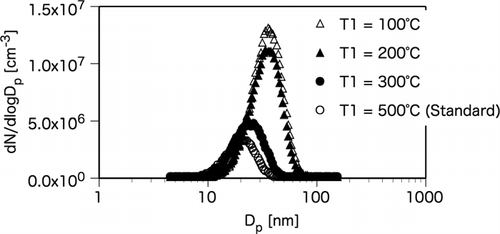
FIG. 7 Number size distributions of oil particles generated under various furnace (T2) and mantle heater (T1) temperatures. The other parameters were fixed at standard operating conditions listed in .

Smaller modal diameters with a lower number concentration of the oil particles were measured under the standard operating conditions, whereas larger diameters and higher number concentrations were observed with lower temperatures of the heater and furnace ( and ). This shows that the particle generation rate depends on temperature. To demonstrate the relationship between oil feed rate and generation rate of oil particles, oil mist and oil particle sampling was conducted. The generation rate of oil particles (generated under the standard operating conditions except for T1 = 200°C and T2 = 60°C) was 3.18 μg min−1 from measurements of air flow rate (cm3 min−1) and particle mass concentration from filter sampling (μ g cm−3), while the oil feed rate was 3.20 μ g min−1. Consequently, the loss of oil mass might be small at lower temperatures. On the other hand, under standard operating conditions with higher temperature, the generation rate of oil particles was 0.39 μg min−1. The loss of oil mass occurred at higher temperatures, but the reason is unclear. One possibility is that diffusion loss occurred at higher temperatures. Another possibility is that the high temperatures inside the tank and heater make the steep temperature gradient to the low temperature of the connection part (e.g., between the tank and the furnace), and nuclei and components of oil were deposited on the wall because of thermophoresis, which results in smaller particles and a lower number concentration was measured at higher temperatures.
Examinations used solely Oil-A, but other oils (Oil-B, PAO) were used for generating particles ( and ). The viscosity of Oil-B at 60°C is a little higher than that of Oil-A; the generated amount of the oil mist was lower at the same temperature of the water bath (60°C). To keep the feed rate of the oil mist of Oil-B the same as that of Oil-A, the temperature of the water bath was raised to 80°C. After adjusting the oil feed rate, oil particles with modal diameter of 20 nm were also generated under standard operating conditions. It was found that generated size distribution is insensitive to the oil viscosity as long as the oil feed rate is identical. When using PAO, the temperature of water bath was set to 60°C. Although the viscosity of PAO is lower than that of Oil-A, oil mists counts measured with dust monitor for PAO were the same as for Oil-A. Larger amounts of oil mist might be generated from PAO; however, most were trapped inside the tube between the oil-feeding unit and the dust monitor. Oil particles of PAO also were generated under standard operating conditions; however, the modal diameter increased to 40 nm with decreased particle numbers. Because no additives were contained in the base oil, nuclei serving as condensation nuclei contained in solvent are thought to be fewer than those in the oil. The particle volume generated from PAO was similar to that generated from the other oils. Therefore, an increase in particle size is reasonable when oil feed rate is constant and number concentration decreases.
FIG. 8 Number size distributions of oil particles of different oils generated under the standard operating conditions listed in . Each oil feed rate was set to 3.20 μg min−1 by changing the temperature of the water bath.
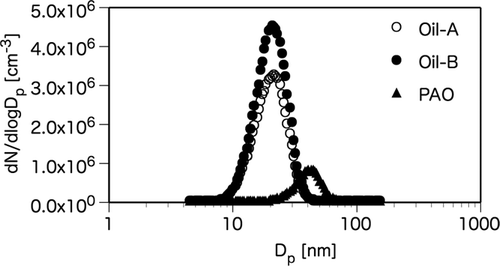
TABLE 5 Parameters of size distributions of oil particles of different oils generated under the standard operating conditions (measured with SMPS 3936; 4–160 nm). Each oil feed rate was set to 3.20 μg min−1 by changing the temperature of the water bath. Corresponding number size distributions are shown in
3.2. Volume Distributions
In studying the effect of nanoparticles, particle mass is an interesting parameter as well as particle numbers. Particle mass is related to volume; here, the particle number size distribution was converted to a volume-weighted size distribution assuming spherical particle shape. We determined the volume-weighted size distribution of the system background (BG), oil supply with ambient temperature (Oil*), and oil particles generated under the standard operating conditions (Oil) using Oil-A measured with SMPS model 3936, 3034, and the OPC (). Modal diameter was found at 20–30 nm, and the volume of particle larger than 100 nm increased in Oil. Volumes of particles larger than 100 nm contributed 30% of total volume. The volume was related to mass: not only the nanoparticles below 30 nm but also those over 100 nm contributed to the particle mass. The volume increment of 200–500 nm in particles generated under the standard operating conditions and in Oil* were similar, which indicated that the oil mist contributed to this size range. There are some ways to exclude the larger oil mist or oil particles, such as removing larger oil mist after bubbling or larger oil particle upstream of the chamber with a cyclone separator or impactor.
FIG. 9 Volume-weighted size distributions of particles in the system background (BG), oil supply with ambient temperature (Oil*), and oil particles generated under the standard operating conditions (Oil) measured with SMPS model 3936, 3034, and the OPC. No particles larger than 300 nm were detected with the OPC in BG.
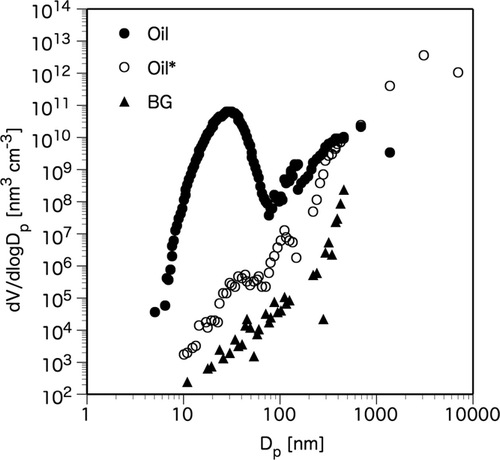
3.3. Organic Carbon and Organic Compounds
Organic carbon (OC) of 20 nm oil particles was measured to ensure that the major part of the mass was organic carbon in the oil component rather than ash from an additive. For the result of OC analysis, OC was seen to comprise up to 80% of total particle weight. Further, we conducted elemental analysis of the original oil to convert OC to organic matter. Carbon and hydrogen dominated 97 wt% of the original oil, and the ratio of (C+H)/C was 1.16. We assumed that this ratio applied to oil particles, which resulted in the organic matter was 96% of particle mass, so oil particles were expected to consist largely of organic compounds. Residual components may be comprised of ash (2% wt) and sulfate (0.8% wt).
We also conducted an organic analysis of the oil particles to check whether components of the original oil had been subjected to distillation. Ion chromatograms (m/z 57) performed on Oil-A particles with different sizes (modal diameter 20 nm; generated under the standard operating conditions, 60 nm; generated under the standard operating conditions except for T1 = 200°C and T2 = 60°C) and original oil are shown in . All of the chromatogram humps were similar, centered around 19–20 min. Compositions of oil particles were qualitatively similar to those of the original oil, and seemed to be not subjected to distillation of organic compounds. Note that we attribute peaks at retention time before 15 min of 20 nm particles to some contamination or pyrolysis product of oil compounds, and the peak at retention time 18 min of 60 nm particles to contamination by diethylhexyl phthalate.
FIG. 10 Ion chromatograms (m/z 57) measured with TD-GC/MS. The chromatograms are oil particles with different size (a modal diameter 20 nm; generated under the standard operating conditions, 60 nm; generated under the standard operating conditions except for T1 = 200°C and T2 = 60°C) and original oil. * and ** indicate contaminations of diethylhexyl phthalate and some contamination or pyrolysis product of oil compounds, respectively.
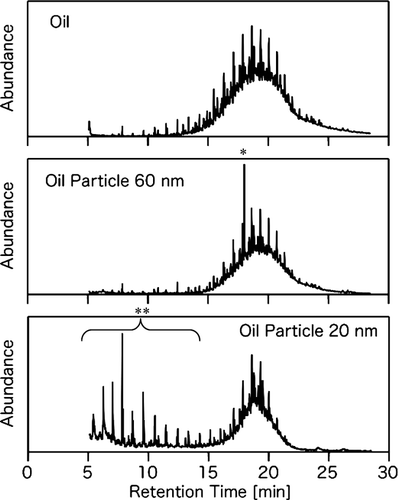
4. CONCLUSION
Lubricating motor oil particles could be generated without addition of condensation nuclei. Quasi-monodisperse particles with a modal diameter located at 20 nm and total number concentrations above 106 cm−3 were generated. Ten reproducibility tests over 2 h were conducted, and particle size and total number concentrations were stable with the number geometric mean diameter 20.0–26.8 nm, geometric standard deviation 1.32–1.34, and total number concentrations 1.0–2.9 × 106 cm−3. The NPG-100 showed good performance in continuation and reproducibility of generated particles. The volume modal diameter was found at 20–30 nm, and the volume of particle larger than 100 nm increased. OC made up to 80% of total particle mass. Organic compounds of oil particles were similar to those of the original oil, and seemed to be not subjected to distillation of organic compounds. The supply of oil was a critical factor for generating the oil particles. Temperatures of the furnace and mantle heater were important for regulating particle size (20–60 nm). Using these techniques we were able to conduct an inhalation study of the oil particles by connecting a nose-exposure system. Toxicity of particles with a 20 nm size combined with organic compounds of oil can be assessed with an in vivo study.
Although we could successfully generate nanoparticles by an evaporation-condensation process using fresh oil, further studies may (1) fully elucidate the mechanisms by which lubricant motor oil nanoparticles are generated in the engine and reaction processes occurring in the engine (e.g., by evaporation-condensation, pyrolysis, and transformation) or (2) identify minor toxic organic compounds in the lubricant oil emitted from the engine. At that time, further studies will be needed to generate nanoparticles in a manner analogous to that occurring in the engine and to evaluate nanoparticles including such toxic organic components.
Acknowledgments
Part of this study was funded by a commission research fund from the Japan Ministry of the Environment. We would like to thank Dr. S. Wakamatsu (PM2.5 & DEP Research Project, National Institute for Environmental Studies now Ehime University, Faculty of Agriculture) for encouragement and Dr. S. Hasegawa (PM2.5 & DEP Research Project now Asian Environmental Research Group, National Institute for Environmental Studies) for maintaining the carbon analyzer.
Notes
*Assuming particle is spherical.
**Assuming relative density is 1.
*Assuming particle is spherical.
**Assuming relative density is 1.
*Assuming particle is spherical.
**Assuming relative density is 1.
REFERENCES
- Charron , A. and Harrison , R. M. 2003 . Primary Particle Formation from Vehicle Emissions during Exhaust Dilution in the Roadside Atmosphere . Atmos. Environ. , 37 : 4109 – 4119 .
- Chow , J. C. , Watson , J. G. , Crow , D. , Lowenthal , D. H. and Merrifield , T. 2001 . Comparison of IMPROVE and NIOSH Carbon Measurements . Aerosol Sci. Tech. , 34 : 23 – 34 .
- Elder , A. , Gelein , R. , Finkelstein , J. , Phipps , R. , Frampton , M. , Utell , M. , Kittelson , D. B. , Watts , W. F. , Hopke , P. , Jeong , C. H. , Kim , E. , Liu , W. , Zhao , W. X. , Zhuo , L. M. , Vincent , R. , Kumarathasan , P. and Oberdorster , G. 2004 . On-Road Exposure to Highway Aerosols. 2. Exposures of Aged, Compromised Rats . Inhal. Toxicol. , 16 : 41 – 53 .
- Evans , D. E. , Harrison , R. M. and Ayres , J. G. 2003a . The Generation and Characterization of Elemental Carbon Aerosols for Human Challenge Studies . J. Aerosol Sci. , 34 : 1023 – 1041 .
- Evans , D. E. , Harrison , R. M. and Ayres , J. G. 2003b . The Generation and Characterization of Metallic and Mixed Element Aerosols for Human Challenge Studies . Aerosol Sci. Tech. , 37 : 975 – 987 .
- Fushimi , A. , Hasegawa , S. , Fujitani , Y. , Tanabe , K. and Kobayashi , S. Organic Composition of Nanoparticles in Roadside Atmosphere in Japan . European Aerosol Conference 2005 . September 28 August–2 2005 , Ghent , Belgium. pp. 633
- Fushimi , A. , Saitoh , K. , Fujitani , Y. , Hasegawa , S. , Tanabe , K. and Kobayashi , S. Investigation of nanoparticles in roadside atmosphere (2) chemical composition . The 22nd symposium on aerosol science & technology . July 28–30 2005 , Sakai , Japan. pp. 5 – 6 . (in Japanese)
- Hasegawa , S. , Hirabayashi , M. , Kobayashi , S. , Moriguchi , Y. , Kondo , Y. , Tanabe , K. and Wakamatsu , S. 2004 . Size Distribution and Characterization of Ultrafine Particles in Roadside Atmosphere . J. Environ. Sci. Heal. A , 39 : 2671 – 2690 .
- Kittelson , D. B. , Watts , W. F. , Johnson , J. P. , Remerowki , M. L. , Ische , E. E. , Oberdorster , G. , Gelein , R. A. , Elder , A. , Hopke , P. K. , Kim , E. , Zhao , W. , Zhou , L. and Jeong , C. H. 2004 . On-Road Exposure to Highway Aerosols. 1. Aerosol and Gas Measurements . Inhal. Toxicol. , 16 : 31 – 39 .
- Kubo , S. Nucleation particles in diesel exhaust and roadside atmosphere . Proceedings of the 45th annual meeting of Japan society for atmospheric environment . October 20–22 2004 , Akita , Japan. pp. 238 – 241 . (in Japanese)
- Kubo , S. 2005 . Properties and generation mechanism of automobile exhaust nanoparticles , 35 – 60 . Tokyo : New Technology New Science (NTS) . (in Japanese)
- Kubo , S. , Kondoh , T. , Yamamoto , M. , Karasawa , M. and Ito , H. Nanoparticles and fine particles (5) Characteristics of nanoparticles in roadside atmosphere . Proceedings of the 46th annual meeting of Japan society for atmospheric environment . September 7–9 2005 , Nagoya , Japan. pp. 282 (in Japanese)
- Li , N. , Sioutas , C. , Cho , A. , Schmitz , D. , Misra , C. , Sempf , J. , Wang , M. Y. , Oberley , T. , Froines , J. and Nel , A. 2003 . Ultrafine Particulate Pollutants Induce Oxidative Stress and Mitochondrial Damage . Environ. Health Persp. , 111 : 455 – 460 .
- Molnar , P. , Janhall , S. and Hallquist , M. 2002 . Roadside Measurements of Fine and Ultrafine Particles at a Major Road North of Gothenburg . Atmos. Environ. , 36 : 4115 – 4123 .
- Muir , D. C. F. and Cena , K. 1987 . Generation of Ultrafine Silver Aerosols for Inhalation Studies . Aerosol Sci. Tech. , 6 : 303 – 306 .
- Nanzetta , M. K. and Holmen , B. A. 2004 . Roadside Particle Number, Distributions and Relationships between Number Concentrations, Meteorology, and Traffic along a Northern California Freeway . J. Air Waste Manage. , 54 : 540 – 554 .
- Pillai , R. S. , Yeates , D. B. , Eljamal , M. , Miller , I. F. and Hickey , A. J. 1994 . Generation of Concentrated Aerosols for Inhalation Studies . J. Aerosol Sci. , 25 : 187 – 197 .
- Reed , M. D. , Gigliotti , A. P. , McDonald , J. D. , Seagrave , J. C. , Seilkop , S. K. and Mauderly , J. L. 2004 . Health Effects of Subchronic Exposure to Environmental Levels of Diesel Exhaust . Inhal. Toxicol. , 16 : 177 – 193 .
- Roth , C. , Ferron , G. A. , Karg , E. , Lentner , B. , Schumann , G. , Takenaka , S. and Heyder , J. 2004 . Generation of Ultrafine Particles by Spark Discharging . Aerosol Sci. Tech. , 38 : 228 – 235 .
- Shi , J. P. , Evans , D. E. , Khan , A. A. and Harrison , R. M. 2001 . Sources and Concentration of Nanoparticles (< 10 nm Diameter) in the Urban Atmosphere . Atmos. Environ. , 35 : 1193 – 1202 .
- Shi , J. P. and Harrison , R. M. 1999 . Investigation of Ultrafine Particle Formation during Diesel Exhaust Dilution . Environ. Sci. Technol. , 33 : 3730 – 3736 .
- Shi , J. P. , Khan , A. A. and Harrison , R. M. 1999 . Measurements of Ultrafine Particle Concentration and Size Distribution in the Urban Atmosphere . Sci. Total Environ. , 235 : 51 – 64 .
- Takenaka , S. , Karg , E. , Roth , C. , Schulz , H. , Ziesenis , A. , Heinzmann , U. , Schramel , P. and Heyder , J. 2001 . Pulmonary and Systemic Distribution of Inhaled Ultrafine Silver Particles in Rats . Environ. Health Persp. , 109 : 547 – 551 .
- Tobias , H. J. , Beving , D. E. , Ziemann , P. J. , Sakurai , H. , Zuk , M. , McMurry , P. H. , Zarling , D. , Waytulonis , R. and Kittelson , D. B. 2001 . Chemical Analysis of Diesel Engine Nanoparticles Using a Nano-DMA/Thermal Desorption Particle Beam Mass Spectrometer . Environ. Sci. Technol. , 35 : 2233 – 2243 .
- Veranth , J. M. , Gelein , R. and Oberdorster , G. 2003 . Vaporization-Condensation Generation of Ultrafine Hydrocarbon Particulate Matter for Inhalation Toxicology Studies . Aerosol Sci. Tech. , 37 : 603 – 609 .